With over two-feet of snow covering the region, finding an accessible place to watch birds can be nearly impossible. Closed roads and deep snow has narrowed my birding choices to a couple downtown locations. One such place, Cedar Hill Cemetery in Hartford, is fortunately well maintained in winter for automobile and foot traffic alike.
On a recent visit to the Cemetery, I had the fortune of finding a pair of Red-breasted Nuthatch high up in a stand of Eastern Hemlock trees. Since it was a little difficult to see the nuthatches, I decided to draw them in closer by mimicking a bird’s alarm call with a technique called pishing. Within seconds, I had Black-capped Chickadees, Tufted Titmice, Downy Woodpeckers, Brown Creepers, White-breasted and Red-breasted Nuthatches all around me. Even a Yellow-bellied Sapsucker flew in to investigate the disturbing noise. What a surprise, I just called in an entire winter feeding flock!
What is a winter feeding flock? More accurately described as a mixed-species foraging flock, it’s a flock of different bird species that join each other and travel together while searching for food. The formation and movements of these birds typically revolve around the whereabouts of either the Black-capped Chickadee or Tufted Titmouse. Bird species that appear loosely associated with the flock are referred to as “attendants”. Attendants may include kinglets, nuthatches and woodpeckers.
Several theories have been proposed to explain the benefits of winter flock formations. One of the more logical explanations involves the increase in predator detection, specifically from Sharp-shinned Hawks. The more eyes in a flock, the easier it is to spot bird-hunting hawks. Flocking is also thought to enhance the chances of finding food. A flock of birds are more efficient at locating good feeding areas than a single bird.
Foraging flocks can also be beneficial to birdwatchers. They not only hold a variety of species, there just may be an uncommon bird within the flock. For example, a few winters ago I discovered four Pine Warblers in a foraging flock at the West Hartford Reservoir!
The nice thing about winter foraging flocks is that they can be enjoyed in just about any natural setting. Town parks, land trust properties and cemeteries are the perfect places to observe this type of avian behavior. The next time you come across a small group of chickadees, pay close attention to them. There may be more to the flock than meets the eye.

No comments:
Post a Comment